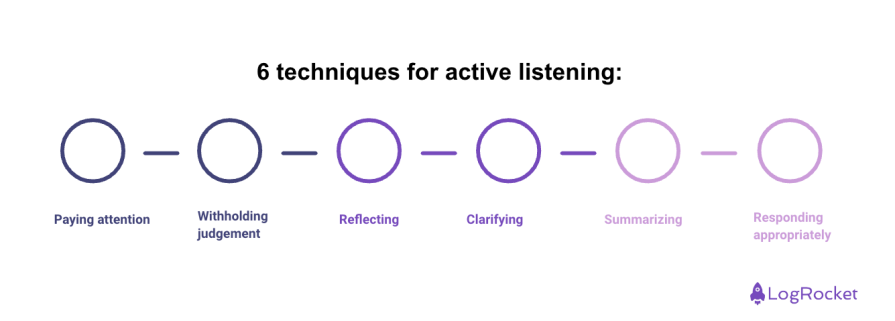This article will introduce you to active listening and explain why it’s a crucial skill for product managers to develop throughout their careers. Whether you’re listening to a customer to gather product clues, a disagreeable coworker, or a product team you’re managing, active listening allows you to see the world through a wider lens. You can also leverage active listening skills to improve your overall productivity and relationships.

Active listening, or purposeful listening, is the act of listening to what someone is saying while observing their non-verbal cues, intonations, and intent. Active listening requires you to recite back what you’re hearing from the speaker in your own words. It’s a very powerful tool because it shows the speaker that you are giving them your full attention, that you care about what they’re saying, and that you’re attempting to see things from their point of view.
In order to improve your ability to actively listen to others, you’ll want to focus on developing six distinct skills:

The first skill, paying attention, has become incredibly difficult to accomplish. Notifications, calls, texts, and other forms of distraction are constantly testing you. That said, identify ways to limit distractions so you can focus on others.
Withholding judgment requires you to silence the roommate in our heads. You know, the one that comments on everything from the way someone is dressed, to the way that someone sounds when they are talking, or even the decision that someone just made.
Setting aside time for mindfulness practices from time to time will help you combat distractions and judgment. Activities such as body scans, mindful breathing, and walking have helped me immensely. I feel calmer, more relaxed, and accepting of the world around me.
At this point, you’re ready to test your understanding of the speaker by reflecting and clarifying what the speaker just told you. For example, if the other person was talking about a pain point they were having at work, you could ask an open-ended question that helps clarify what the pain point was and how severe the pain is for the speaker.
After your clarifying questions have been answered and the speaker has completed, succinctly summarize what you heard using “the rule of three.” The rule of three states that ideas or stories presented in threes are more memorable to the listener. I find that capping my response to three key points forces me to be succinct while ensuring I captured the three most important points of the speaker.
The final step is to respond appropriately to the speaker in an appropriate manner. Depending on the situation, appropriate may be a stern, caring, or neutral response. No matter what your response is, you can rest assured that the other person is much more likely to respond well to you because you took the time to actively listen to what they had to say.
Active listening is a key skill to develop as you move through your career. In a December 2023 study by Gitnux, 64 percent of human resource professionals cited active listening as the most critical leadership skill. This doesn’t mean that active listening is a skill that’s only useful for those in leadership positions.
In fact, many individuals end up in leadership positions because they intentionally developed superior active listening skills throughout their career. In this section, I’ll cover active listening in three scenarios:
The first scenario, customer discovery, is near and dear to me. As a product manager, it’s my job to listen, analyze, interpret and influence. A large part of my role is to listen to customers and active listening plays a huge role in my process.
The most challenging and interesting part of the discovery process is when I’m trying to quantify the pain points of customers through interviews. Quantifying a customer’s pain points is difficult because it isn’t my pain. In order to overcome this challenge, I focus on withholding judgment, reflecting, and clarifying my understanding of customers’ pains so that I can quantify them.
I do this over and over with customers in order to build a segment profile for my stakeholder teams. At the end of the day, it’s my job to best represent my customers’ needs internally and active listening plays a key role in my ability to do that.
The second scenario, dealing with a challenging coworker, is one we all run into from time to time. The next time you run into this scenario, I have a challenge for you: Try to apply active listening skills before responding to your challenging coworker. In fact, start the process before you go into work.
Imagine your coworker is getting ready to go to work. What are they thinking? I can guarantee you that your coworker didn’t wake up in the morning with the goal of being a challenging coworker. They likely have reasons for responding to you in a certain way. Before your next interaction with your challenging coworker, try to remove judgment and really pay attention to what your coworker is saying.
Even if you don’t agree with them on all points, did you agree with them on some of the points? If so, let them know what you agreed with without being judgmental. By clarifying that you agree with them, you’re encouraging them to move from a defensive to a more neutral stance. By making this small shift, you’re starting to build a path towards understanding their perspective, which opens up your mind to new ideas and a potential resolution.
The final scenario is of a department manager receiving indirect feedback from subordinates. This scenario can occur in different ways and one way that I’ve seen is through open forums where questions are submitted either online or in-person. Questions can center around layoffs, strategy, or organizational values.
The challenge in these cases is in balancing the information that’s conveyed while also showing subordinates that you’re truly listening to them. In sensitive situations, the leader is often unable to divulge too much information for legal or financial reasons. Active listening comes in when the leader clarifies and plays back the question or comment from the subordinate and clearly articulates a response that captures the emotion of the subordinate.
Here, the leader shows the subordinate that they understand the concern, they care about the subordinate as a person, and that they’re responding based on the constraints and boundaries of their environment.
Now that we’ve gone through some active listening scenarios, hopefully you are getting a sense of the benefits of active listening.The single largest benefit is that active listening builds strong relationships by instilling mutual trust. Did you ever walk away from a conversation thinking, “Were they even listening?” How did that make you feel?
Probably, not so good. Situations like these often cause you to fill in gaps of understanding with potentially misleading information. Your mind might introduce a thought of mistrust or a misunderstanding when you feel like someone wasn’t listening.
Active listening, on the other hand, fills those gaps with non-verbal behaviors and verbal cues that tell your brain to relax because the other person is clearly trying to understand what you are saying. Even in cases where you don’t agree or don’t like what the other person has to say, you can at a minimum be reassured that the other person heard you out. Long term, active listening builds psychological safety in the workplace and that allows for all team members to feel like they are valued and heard.
Depending on how you’re wired, you may find active listening to be really easy (with a little practice) or really hard. The two largest challenges that I’ve seen people have to overcome are withholding judgment and waiting to respond.
If withholding judgment of others is a challenge for you, I encourage you to consider that we all have different thoughts because we come from different places. Rather than viewing someone else’s ideas as “wrong,” think about some scenarios in which that person could be “right.” For instance, imagine a scenario where someone tells you that they are just paying the minimum fees on their credit card.
Your immediate thought might be, “Well that’s dumb, you are just racking up more debt.” What if then they told you that “I’m only able to pay the minimums right now because my son has cancer and our health insurance is not covering the cost of his treatments.” WOW, big difference huh? Remind yourself that you never have all the information.
If you find that you cannot wait to respond to the person speaking to you, you’re probably skipping skills 3, 4, and 5 above. Basically, you’re failing to clarify, reflect and summarize what the other person is saying and skipping straight to a response. Ultimately, you have to ask yourself, “Why am I doing this?”
Is it because you feel like you need to have more power in the relationship? Do you want to control what the other person is thinking? Do you feel the need to be “right”?
These questions require some introspection on your end and oftentimes you’re simply not aware that you have a problem that needs to be addressed. If you are fortunate enough to have a mentor, friend, or a good manager that’s pointing out these issues to you, take the necessary steps to stop and reflect. In the end, by failing to listen, you’re disconnecting with others and over time, eroding your relationships.
As a product manager, I cannot stress how important active listening skills are in conversations with customers, peers, developers, and executives. Product management is an influencing role and in order to influence others you need to understand them — what motivates them, what drives their decisions, and why they do the things they do.
One of the best ways to understand other individuals is through active listening. As a recap, here are the six skills you can develop to become a better active listener:
If you take the time to master each one of these skills, I can assure you that your ability to perform your job, no matter what it is, will increase significantly. More importantly, your relationships with others will strengthen and in the long term, your relationships are really what counts.
Featured image source: IconScout

LogRocket identifies friction points in the user experience so you can make informed decisions about product and design changes that must happen to hit your goals.
With LogRocket, you can understand the scope of the issues affecting your product and prioritize the changes that need to be made. LogRocket simplifies workflows by allowing Engineering, Product, UX, and Design teams to work from the same data as you, eliminating any confusion about what needs to be done.
Get your teams on the same page — try LogRocket today.

A practical five minute revenue estimation method to help product managers compare ideas, drop low impact features, and prioritize smarter.

A practical guide for PMs who want to stop being bottlenecks, delegate smarter, and lead teams effectively with a clear ownership framework.

Stop letting unreliable data block features. Treat data as inventory to track quality, ownership, and ship with confidence.

Learn why slide decks slow teams down and explore better tools like whiteboards, PRDs, and prototypes to improve collaboration and alignment.